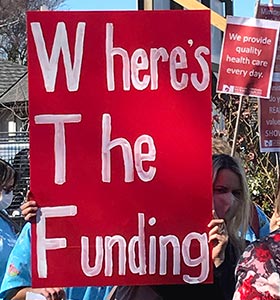
Pay parity for primary health care (PHC) nurses has proved an elusive goal. And PHC nurses and medical receptionists are getting tired of waiting. They have voted overwhelmingly in favour of two 24-hour strikes this month – the first on November 9, followed by another on November 23. This action follows their inaugural eight-hour strike on September 3.
A combination of factors is behind the historic industrial action. PHC nurses’ sense of injustice – an experienced PHC nurse is paid 10.6 per cent less ($7600 a year) than a district health board (DHB) nurse with the same experience and qualifications. A feeling they have been fobbed off for too long – the latest push for pay parity has been going on for the last two years. Before 2018, PHC pay rates had been within cooee of DHB pay rates, but the last DHB multi-employer collective agreement (MECA) widened the gap considerably. A sense their work is undervalued and misunderstood – the skills required to work in PHC, with presentations covering the whole gamut of health care, are no less valuable than those required in the DHB sector. And a certain cynicism at the gap between the rhetoric about nurses’ great work during the continuing COVID-19 pandemic and the reality of the growing pay gap. As one PHC nurse said: “Clapping hands and words of thanks don’t pay the bills”.
Seeking resolution
NZNO members have done everything in their power to achieve pay parity without striking – agreeing to a one-year PHC MECA for 2018/19 in the hope extra government funding would be forthcoming. Preparing a paper with the New Zealand Medical Association (NZMA), which represents the vast bulk of PHC employers, detailing the case for pay parity. Meeting the then Health Minister David Clark with NZMA representatives to press their case. Continuing negotiations with NZMA in good faith, despite the lack of additional funding. Seeking support from the chief nursing officer Margareth Broodkoorn and director general of health Ashley Bloomfield. Attending last-minute mediation before the September 3 strike. Writing a pre-election open letter to Prime Minister Jacinda Ardern calling for her support.
And in their battle for pay parity, PHC nurses are in the rare situation of being supported by their employers. Employers’ support is driven by two factors. The first is the need to recruit and retain PHC nurses. In an NZNO survey of PHC nurses early this year, 70 per cent of respondents said they were contemplating leaving the sector for higher pay elsewhere. NZNO is now hearing of employers advertising for nurses and getting few, if any, responses. The second is by employers’ own campaign for sustainable general practice. They believe more government funding is needed for both capitation and co-payments.
The cost of pay parity for PHC nurses is estimated at around $15 million. The current Health and Education Minister, Chris Hipkins, found additional money earlier this year to boost the pay of early childhood education teachers to solve that sector’s recruitment and retention issues. These teachers, on the whole, work for private providers. The same lifeline has not been extended to PHC nurses or their employers, who face the very same issue. The fact that PHC negotiations are underway and are in the private sector seem to be the excuse for government inaction, despite the precedent that was set here.
PHC nurses’ hopes were lifted following a meeting between employers and Ministry of Health and DHB representatives in September. A statement following that meeting, acknowledged that pay parity needed to occur across the PHC sector, with the initial focus on the PHC MECA. But in a letter to NZNO late last month, Hipkins seemed to be resiling from that. He said it was not appropriate for him “to comment on or intervene in this bargaining”.1 But former Health Minister David Clark stumped up $38 million to get a DHB MECA across the line in 2018.
Pay parity for all nurses
It is not right that one group of nurses is forced to take strike action in an attempt to get the same pay as another group of nurses. All nurses, regardless of where they work or who they work for, should get the same pay.
If this situation is not resolved, there will be an exodus of nurses from PHC. And that will have an escalating impact on secondary health services, as many of those unable to access PHC will end up in hospitals with entirely preventable health conditions.
Reference
- Office of the Minister of Health. (2020). Letter to NZNO industrial adviser Chris Wilson.



